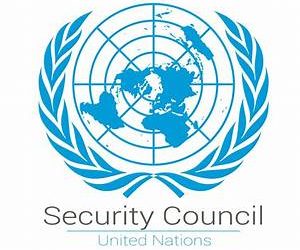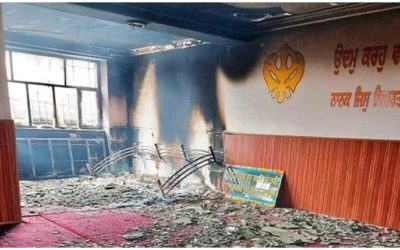KATHMANDU VALLEY, Nepal — Deftly handling tiny chisels and swabs of cloth, a dozen village women painstakingly chip away the crust and grime of centuries, restoring to life images of Brahma, Vishnu and other Hindu deities that grace an architectural masterwork.
The skilled workers are putting the finishing touches to a shrine at Changu Narayan, a holy site becoming doubly renown: It is Nepal’s oldest Hindu temple and the first of numerous artistic treasures to be resurrected following the April 25, 2015 killer earthquake.

Local residents relax at a shrine propped up by wooden beams on Kathmandu’s earthquake-damaged Durbar Square despite a warning that the building is unsafe. (Photo by Denis Gray)
One year later, the temples and palaces at the world’s largest concentration of UNESCO World Heritage Sites remain heaps of rubble. Other structures that had suffered seismic damage were still being propped up by wooden beams, the victims, experts say, of Nepal’s political infighting, bureaucratic lethargy, dearth of resources and possible corruption. This is despite millions of dollars pledged by international donors.
Similarly, the government has yet to distribute the $5,000 in grants and soft loans promised to thousands of families to rebuild their quake-ravaged homes.
At a magnitude of 7.8, the earthquake cut a swath of destruction in the Kathmandu Valley and other regions of this Himalayan nation, leaving more than 8,600 dead and half a million homes destroyed in its wake. It also decimated or damaged, by the government’s estimate, nearly 3,000 religious and culturally significant sites. UNESCO says it will take some $200 million to restore these monuments.

Nepali women pose before a popular shrine on Kathmandu’s Durbar Square, residence of Nepal’s kings until the 19th century. The square was severely damaged in the quake. (Photo by Denis Gray)
“There was a real rush of goodwill after the quake, together with lots of chaos and duplication,” said Stefaan Poortman, executive director of the U.S.-based Global Heritage Fund who visited Nepal recently. “Then there was a period of emergency conservation. But now we have a bottleneck in the government, with organizations waiting for restoration projects to be approved.”
Suresh Suras Shrestha, who heads the World Heritage Conservation Section in the Department of Archaeology, told the Nikkei Asian Review that work on some major sites will begin in a few months, with tenders already out to 49 contractors. The government, he said, was following a five- to seven-year guideline, with the first post-earthquake year designated for planning.
Foreign donors have pledged an initial $7 million for the restoration effort on condition that the funds are used by mid-July this year, a deadline likely to be missed given the current impasse. Even UNESCO, with a budget for another $2 million, was ordered to stop restoration work on a stupa at Kathmandu’s Swayambhu Buddhist monastery. “The donors ask: ‘What have you done with our money?’,” said Christian Manhart, head of UNESCO in Nepal.

A vendor sells corn for feeding pigeons on Kathmandu’s Durbar Square, the site of historical architectural masterpieces. (Photo by Denis Gray)
The Kathmandu Valley Preservation Trust, a 25-year-old non-governmental organization, was only given permission earlier this month to begin post-earthquake work at Patan Durbar Square, a former royal complex of intricately decorated temples, courtyards and sunken baths most dating back to the 17th century. It is one of three such squares, all severely damaged World Heritage Sites, in the Kathmandu Valley.
At Kathmandu Durbar Square, as evening sets in, children feed swarms of pigeons; the faithful place candles at altars; and lovers rest on the steps of damaged temples, ignoring the “Danger Zone” signs. There is no evidence of work in progress on the mangled monuments.
“This is not a technical problem but rather a political and bureaucratic one,” said Rohit K. Ranjitkar, the trust’s Nepal program director. “There have been too many changes of government and when a new government takes over, everything starts from scratch.”
Living history
Beyond the issues of tourism income or heritage preservation, the conservation architect says the battered sites are “living monuments of a living culture” where people flock for religious rites, festivals and solace from daily woes. Where restoration has occurred, it has sprung from local initiative and donations — not from the government.
“People are depressed and frustrated because nothing is happening. It’s not nice. But what to do?” Ranjitkar asked.
Breaking through the bottleneck may prove difficult given recent legacy: the wrenching abolition of absolute monarchy in 2008, a decade-long Maoist civil war and endless changes of inept governments. Also impeding recovery from the earthquake is a new constitution and a crippling, nearly five-month-long blockade of the vital border with India, widely believed instigated by New Delhi in reaction to Nepal’s domestic politics. Endemic corruption persists, with the country ranked 130 out of 168 nations on the 2015 Corruption Perceptions Index compiled by Transparency International.

Nepali women pose before a popular shrine on Kathmandu’s Durbar Square, residence of Nepal’s kings until the 19th century. The square was severely damaged in the quake. (Photo by Denis Gray)
A tower of the former royal palace in Patan Durbar Square under scaffolding as workers repair extensive damage from last year’s earthquake. (Photo by Denis Gray)
Experts involved in conservation interviewed said graft and corruption were a potential problem now and when sizeable funds started flowing in from abroad.
Shrestha denied those corruption charges, but acknowledged problems in finding honest, high-quality contractors and that his department was still struggling with meager funding, which has yet to be boosted from a central government agency. Only a scant database exists on the affected monuments, something vital in diagnosing their ills and deciding on how best to retrofit them.
Other hurdles face the conservationists, including shortages of key, traditionally used materials as well as technicians and craftsmen. The large-sized timber needed for beams and pillars is in short supply and must be pre-ordered months in advance. The mass-produced bricks available on the market are deemed unsuitable to replace those shattered by the earthquake, and even the only producer of traditional-style bricks, despite enjoying a monopoly, does not or cannot replicate the superb quality of the past.

Conservation architect Shekhar Dongol poses by the Shree Kileshwor Shiva temple, the first in Nepal to be restored after the quake. The architect headed the restoration team from John Sanday Associates. (Photo by Denis Gray)
Shekhar Dongol, an architect who led the revival of the shrine at Changu Narayan, says a philosophical debate continues, perhaps stalling rehabilitation work, on how the stricken monuments should be conserved, and whether concrete or wood should be used in the renovations.
Some like Dongol and Ranjitkar believe in compromise, a middle way between wholesale reconstruction using modern materials and technology, and totally bowing to traditional methods. Such an approach would mean using materials and techniques of the past as much as possible while shoring up vulnerable areas with modern means that would better withstand future earthquakes and the wear-and-tear of time.

An expert wood carver fashions part of a window frame to replace one destroyed in last year’s earthquake at Nepal’s oldest Hindu temple of Changu Narayan. (Photo by Denis Gray)
The most difficult challenge at Changu Narayan was getting the official go-ahead to work there.
John Sanday Associates, where Dongol is employed, had been seeking permission to rejuvenate the deteriorating temple since 2010. “The heritage sites are not well maintained. Private contractors the government hires just do patch-up work. They forget to do such ‘minor things’ like strengthening foundations,” Dongol said.
The government finally gave the nod in January, following mounds of paperwork and ceaseless efforts to penetrate the bureaucratic labyrinth, needed despite the firm’s sterling reputation. Its head, British conservation architect John Sanday, has worked for international organizations at Cambodia’s Angkor and on numerous projects in Nepal, where he has resided for four decades.
Obtaining $20,000 from the German government, Sanday and his team targeted the Shree Kileshwor Shiva shrine at Changu Narayan, a hilltop site abutting a charming village of some 200 houses. The earthquake had sheared off the second storey of the resthouses surrounding the temple compound, which dates back to the 6th century, and pulverized two small shrines, killing a child who was sitting beside one of them.
At the Shiva shrine, which had buckled and was in danger of collapsing, the team reinforced the structure with new timber, added known missing parts and repaired the brickwork, using existing late-17th century bricks on the shrine’s lower section and new ones on the upper. Local women, trained by a French conservation expert, set to work cleaning this little jewel.
Above the Shiva shrine looms the compound’s main temple, dedicated to Vishnu, at which a Hindu priest, Ram Prakash Bhatta, comes daily to pray as his forefathers had done for more than three centuries.
Dongol says that the firm hopes to bring this temple and the entire compound back to life fully within four to five years, and there are sound prospects for funding from Australia, Germany and the U.S. John Sanday Associates wants to go it alone.
“If we look to the government it will take a very long time,” Dongol said. “There are the politics.”




0 Comments